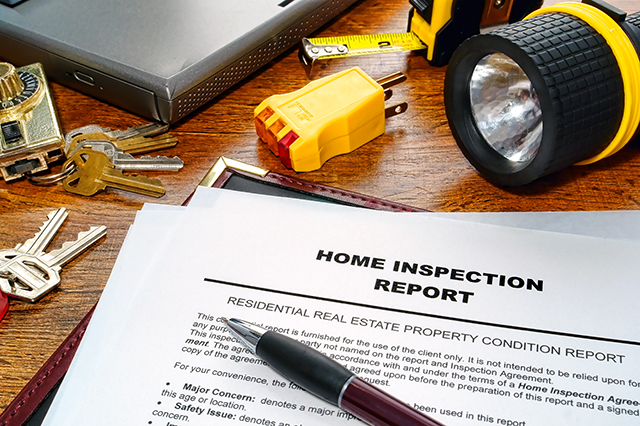You spent months finding the home of your dreams, you put in your offer and it was accepted – but it’s not time to celebrate just yet. Before you close the deal, you need to know exactly what you’re getting into. No house is perfect, but some defects are more costly than others to fix. Armed with the results from a defect checklist for a new house, you can likely negotiate a lower price.
A thorough home inspection enables the buyer to have a realistic understanding of the impact of what they are getting themselves into in terms of insurability, according to Ray Eng, vice president of insurance sales for AAA Northeast. “It might look like it’s full of character [to you], but that’s not how insurance companies might look at it.”
“Unless you are paying cash for the property, your lien holder will require you to have insurance in place before they release the money to you,” adds Eng. Most insurance companies have some sort of inspection requirement from an exterior inspection to an actual walk-through of the home. “The insurance company inspector probably isn’t going to pull out a ladder to climb on your roof or get into the crawlspace,” says Eng. “But the [inspector] that the homeowner hires should actually be doing that.”
The home inspection looks through the lens of what you, as a new homeowner, would be getting yourself into. “[Sometimes the buyer mistakenly] has the expectation that the seller will repair everything the engineer finds. The purpose of a pre-purchase inspection is to advise a prospective purchaser of the condition of the house. The purpose is not to create a list of what the seller is going to correct,” says Hal Krongelb, chief engineer at Heimer Engineering PC in New York.
Krongelb, who conducts pre-purchase home, building, condo and co-op inspections, explains that there is often an expectation for the engineer to give a prospective buyer a “yes” or “no” answer on purchasing the house. “It is rarely that clear cut when purchasing a home. The purpose of the pre-purchase inspection is to make the prospective purchaser better informed about the house. It is up to a prospective buyer to make the choice as to whether to purchase the house.”
Pre-purchased home inspections that the buyer schedules can be executed by a licensed home inspector or engineer. It’s up to the buyer to ask about – and understand – the differences in how these two types of individuals/companies approach the work at hand, the detail level of their reporting and how they charge. Be sure to do your homework so you know which is best suited for your needs.
Check out these common questions to ask before a home inspection.

Defects to Look For
To be sure all bases are covered by the professional home inspector’s investigation, your personal defect checklist for a new house should include the following.
Walls and ceilings. Be aware of cracks, holes, chips, wavy and uneven surfaces, missing plaster, fungus, water marks, lumps, bubbles, flaky paint, protruding nails, pipes and loose wiring.
Doors and windows. Check for damage such as missing screws or rust and gaps between door and window frames. Make sure they can be opened and closed easily and look for potential water damage due to improper installation.
Floor and tiles. Are there missing, cracked or chipped tiles? Tiles should not be slanting and there should be no gaps in the wall skirting.
Fixtures. Make sure all sinks and showers have fixtures. Ensure everything works and nothing is missing.
Pipes and plumbing. Check exposed pipes for leaks and be on the lookout for water stains on ceilings, which can signal a leak behind a wall. Low water pressure can also be a symptom of faulty plumbing.
Wiring. Look for wires without wire nuts and open junction boxes.
Drainage. Soggy areas in the yard and leaks in the basement can signal drainage issues.
Roof and gutters. Look for worn shingles and overgrown trees or landscaping that is encroaching on the roof or overhanging the structure. Basement dampness can be a sign of clogged gutters.
Foundation. Small cracks, sticking doors and windows can suggest foundation flaws.
Potential Deal Breakers
According to the American Society of Home Inspectors, the most common issues identified on a home inspection checklist are usually the easiest and least costly to address; however, they may be an indication of bigger, pricier problems.
The roof needs replacing. According to Home Advisor, the national average for a roof replacement is nearly $8,000.
The house is in a flood zone. Use FEMA’s flood maps to determine if the home is at risk. Remember, flood insurance needs to be purchased separately from your regular home insurance policy. Contact an experienced AAA Insurance agent today to learn more.
Major foundation issues: Hire a structural engineer to determine if the cracks you spot are serious.
Aluminum wiring: This type of wiring almost always needs to be replaced. The process can cost thousands of dollars.
Once you have your home inspection report – essentially, a custom defect checklist for a new house – you can determine if negotiations with the seller are reasonable.
Some inspectors might estimate the remaining useful life of appliances or other systems for you (this is something to ask before you hire your inspector). You can also get your own repair and replacement bids from local contractors and home improvement stores.
The more due diligence you commit to upfront, the happier you will be when you take ownership of your new home with your eyes wide open.
Do you have any advice to add from your home buying experience? Share it in the comments.
2 Thoughts on “Must-Check Defect Checklist for a New House”
Leave A Comment
Comments are subject to moderation and may or may not be published at the editor’s discretion. Only comments that are relevant to the article and add value to the Your AAA community will be considered. Comments may be edited for clarity and length.


















Have home inspector show buyers how to shut off entire water supply and electrical panel in case of an emergency.
Make sure there are screens for the windows. Make note of any windows missing proper screens.